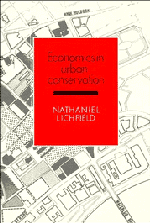Book contents
- Frontmatter
- Contents
- List of diagrams, tables and plans
- Preface
- Acknowledgements
- Introduction
- Part I Planning and management in the conservation of the urban system
- Part II Conservation of the cultural built heritage
- 4 The nature of the cultural built heritage
- 5 Identification and protection of the CBH
- 6 Management and planning in the conservation of the urban cultural heritage
- Part III Economics in urban conservation
- Part IV Selected tools of economic analysis for project evaluation
- Part V Case studies in the economics of conservation of the CBH
- Notes
- Bibliography
- Index
6 - Management and planning in the conservation of the urban cultural heritage
Published online by Cambridge University Press: 10 November 2010
- Frontmatter
- Contents
- List of diagrams, tables and plans
- Preface
- Acknowledgements
- Introduction
- Part I Planning and management in the conservation of the urban system
- Part II Conservation of the cultural built heritage
- 4 The nature of the cultural built heritage
- 5 Identification and protection of the CBH
- 6 Management and planning in the conservation of the urban cultural heritage
- Part III Economics in urban conservation
- Part IV Selected tools of economic analysis for project evaluation
- Part V Case studies in the economics of conservation of the CBH
- Notes
- Bibliography
- Index
Summary
Relation of planning and management
We saw above (2.5.5) that the process of planning and management are closely inter-related, with the difference of emphasis in particular situations stemming from the vantage point of the institution concerned and its professional advisers. In this context, in relation to urban and regional planning, we saw that it is conventional to see management as the implementation of policies, strategies, proposals, plans and programmes. That is the emphasis in this chapter.
It will also be seen from the title of the chapter that we are referring to the ‘urban cultural heritage’ and not the ‘cultural built heritage’. This is to introduce the twin aspects of the urban system (the physical stock and the related human activities) into our planning and management of the urban cultural heritage, even though for reasons already displayed (4.8) the cultural activities are not necessarily found in the cultural built heritage itself.
Role of the CBH in urban planning
The roles of conservation and planning (3.2, 3.3, 3.4) take on special emphasis when considering the future of the CBH.
As we have seen (5.1), where society decides to impose conservation constraints upon owners in the renewal of heritage property, it is in effect asking them to make management decisions on the future of their property which balance their own proprietary interests with the social objectives of conservation. For this purpose society needs to intervene in the market process. And, as we saw above (5.3), for such intervention it needs to arm itself with legal powers which override the general laws of property; with administrative machinery for implementation; and with financial resources where these are needed to support the conservation programme.
- Type
- Chapter
- Information
- Economics in Urban Conservation , pp. 91 - 110Publisher: Cambridge University PressPrint publication year: 1989



